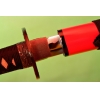|
 The
Oriental things are always in. They are mysterious, strange to our culture and
thus so attractive. Utilitarian West is attracted to philosophical East, as all
is attracted by something unusual and magic. No wonder that elements of
cultural and everyday life become the core of collectors' activity. The Japanese
weapon is the special stuff that personifies the unique technologies and
external elegance, on the top of it, is the quintessence of philosophy and culture
of the Japanese nation. The
Oriental things are always in. They are mysterious, strange to our culture and
thus so attractive. Utilitarian West is attracted to philosophical East, as all
is attracted by something unusual and magic. No wonder that elements of
cultural and everyday life become the core of collectors' activity. The Japanese
weapon is the special stuff that personifies the unique technologies and
external elegance, on the top of it, is the quintessence of philosophy and culture
of the Japanese nation.
Therefore,
collection of the Japanese weapons wins more and more hearts of people. The katanas
are not any longer just images in the specialized literature. Yet, they become VIP-present.
However, it is somehow difficult to define what kind of weapon to acquire for
the collection.
First, you need
to identify what exactly is eligible to collect. When you collect katanas, this
collection is considered in one way, but collection of Japanese swords is
something different. The point is that katana is one of the Japanese swords.
This is well-practiced belief though wrong. Katana is the Japanese sword, but
the Japanese sword is not necessarily katana. Nihon To that stands for Japanese
sword in Japanese language includes almost all weapons with the blade excluding
the Kama and the Shuriken, meaning «a dagger hidden in a palm»'. Nihon To includes
swords, different types of the Wakizashi, Yari and Katana. Here «То» meaning
sword is not to refer to all swords but only to arched and with single-sided sharpening.
Actually the technology to make blades is similar, while size, shape and task
differ.
In addition,
collectors might pay their special attention to furniture for swords. Thus, Katana
is the unique kit to construct from various parts. Some time ago every part
used to be made by the qualified master and all the parts were removable. Most
frequently the collectors prefer tsuba, the flat bow, for their collections.
Tsubas were manufactured from the special alloy shakudo (copper, silver, tin
and gold), yet, they were of stunning beauty. Japanese menuki is a part of a
Samurai sword represented as small figures also frequently appreciated and collected.
The menuka designed in the form of a pair of mythological rhinoceroses are crafted
with shakudo bodies.
The person who
just comes to the idea to collect finds it a bit difficult to choose what to start
with, yet, the attractive appearance of the item is not the attribute of the
real weapon. The true katana looks splendid though it possesses other features,
and the simplest thing is to produce fake katana. Above all, even the «hamon» line
(hardening line, temperature line) that goes along the blade is deemed to be
the distinctive feature of the true katana, though it is not the ‘quality
sign'. This line is very easy to falsify, just etching or facing on the surface
of the blade. The genuine Japanese weapon gets the «hamon» line in process of
steel hardening, and it parts the hard steel from the soft iron.
Before you
start acquiring things for your collection, you'd better study the Japanese
weaponry as well as the Japanese philosophy, world outlook, Bushido code of the
Japanese warriors. Also you need to know the basic principles of weapon
manufacture, types and shapes of weaponry, the history and process of weapon
production development. Providing you know all these facts, it is not
complicated to make a choice and acquire the genuine thing but not the outright
fake. Currently lots of books are published with the purpose to help the beginners-collectors
of the Japanese weapon. Yet, the book tells about everything important for the collector.
The books with plenty of pictures and descriptions of the weapon types (sometimes
pictures are not enough) and the books are easily accessible and popular among
the specialists and the wide readership.
The price
of the weapon is also determining factor for collectors. So, katana is rare to find
for less than $3000-5000USD. And this is the price for the modern katana while
the ancient type of weapon costs the fortune, somewhat not affordable even to
the wealthiest collectors.
Old time katanas
have a unique mark of high quality which says the tests the blade was exposed
and the test outcomes. So, the traditional test included the cut of bunch of rigid
bamboo, while the most aggressive warriors used to cut two corpses tied up
together. Once you decided to acquire the weapon for your collections, you'd
better go to specialized stores or at auctions where experts inspect and
evaluate them. The beginner is the easiest prize for the tricksters unless the
former learns to identify the quality of the subject to be bought. Here, the purpose
varies based on whether you want just a souvenir resembling the Japanese weapon
or the real sword. The store will openly provide the information about this. The
souvenirs also might be expensive, splendid and quality, though being
souvenirs.
|